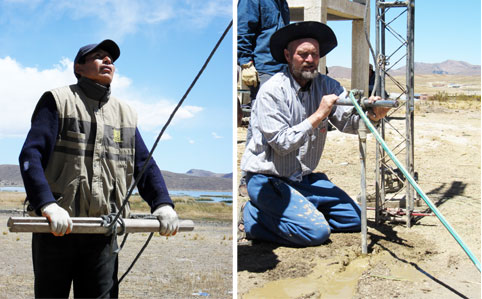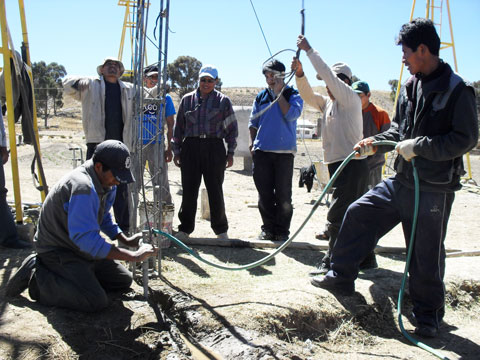Difference between revisions of "Solution of the week 11"
(New page: __NOTOC__ ==Drilling boreholes the Bolivian way - the EMAS method== Around the world, most boreholes are drilled with big, heavy equipment which arrives by truck, makes a lot of noise, an...) |
|||
| (2 intermediate revisions by the same user not shown) | |||
| Line 15: | Line 15: | ||
The EMAS concept that he has developed consists of a complete set of low-cost water and sanitation technologies, such as manual well drilling, water pumps, windmills, irrigation, solar water heating, latrines, and ferrocement tanks. Movies describing all the technologies are available in this [http://vimeo.com/channels/emas EMAS Vimeo channel]. | The EMAS concept that he has developed consists of a complete set of low-cost water and sanitation technologies, such as manual well drilling, water pumps, windmills, irrigation, solar water heating, latrines, and ferrocement tanks. Movies describing all the technologies are available in this [http://vimeo.com/channels/emas EMAS Vimeo channel]. | ||
| − | + | [[Image:emas2.jpg|thumb|center|480px|Overview of EMAS drilling site.]] | |
====The EMAS method==== | ====The EMAS method==== | ||
| − | In the course of 25 years, Wolfgang has perfected a manual drilling method which can be adapted to a range of conditions, and has trained some 400 local people in the art of well drilling. To get an impression of the drilling technique have a look at the movie. The EMAS method is mainly used in Bolivia, Panama, Ecuador, Paraguay, Brazil, Peru, Honduras, Nicaragua, El Salvador, Guatemala, Eritrea and Sri Lanka. | + | In the course of 25 years, Wolfgang has perfected a manual drilling method which can be adapted to a range of conditions, and has trained some 400 local people in the art of well drilling. To get an impression of the drilling technique have a [http://vimeo.com/8356556 look at the movie]. The EMAS method is mainly used in Bolivia, Panama, Ecuador, Paraguay, Brazil, Peru, Honduras, Nicaragua, El Salvador, Guatemala, Eritrea and Sri Lanka. |
A complete drilling rig, suitable for boreholes up to 40 metres deep, can be built in Bolivia for about $800. This includes the tower, mud pump and all essential tools to operate and maintain it. The low price means that it is very cheap for someone to start up his or her own small drilling enterprise, and this is exactly what has happened on a large scale in Bolivia, where borehole drilling services are now widely available from the local private sector. | A complete drilling rig, suitable for boreholes up to 40 metres deep, can be built in Bolivia for about $800. This includes the tower, mud pump and all essential tools to operate and maintain it. The low price means that it is very cheap for someone to start up his or her own small drilling enterprise, and this is exactly what has happened on a large scale in Bolivia, where borehole drilling services are now widely available from the local private sector. | ||
| Line 26: | Line 26: | ||
====Links==== | ====Links==== | ||
| − | + | *[[Akvo_water_solution_of_the_week| Other blogs in this series]] | |
| − | *[[Akvo_water_solution_of_the_week| Other blogs in this series] | + | *[[Jetting_-_EMAS_method| Akvopedia article on EMAS well drilling]] |
| − | *[[Jetting_-_EMAS_method| Akvopedia article on EMAS well drilling | + | *[http://vimeo.com/8356556 Movie on EMAS well drilling method] |
| − | *[http://vimeo.com/8356556 EMAS well drilling method] | + | *[http://vimeo.com/8357122 Movie on Materials needed for EMAS well drilling] |
| − | *[http://vimeo.com/8357122 Materials needed for EMAS well drilling] | + | * Alternative methods: [http://vimeo.com/8365486 movie on EMAS well drilling by suction], and [http://vimeo.com/8357733 movie on EMAS well drilling by sludging] |
| − | * Alternative methods: [http://vimeo.com/8365486 EMAS well drilling by suction], and | ||
*[http://www.unicef.org/wash/index_watersecurity.html Information on UNICEF website on manual drilling (see technical note series)] | *[http://www.unicef.org/wash/index_watersecurity.html Information on UNICEF website on manual drilling (see technical note series)] | ||
Latest revision as of 09:44, 3 March 2010
Drilling boreholes the Bolivian way - the EMAS method
Around the world, most boreholes are drilled with big, heavy equipment which arrives by truck, makes a lot of noise, and gets the job done in a short time, at a cost of about $5,000 to $20,000 per borehole. But there is a growing interest in doing it in a different way — drilling by hand. It takes longer, it is heavy work, but it also gets the job done. Why are people getting interested? A hand-drilled borehole costs about $500 or less.
This large difference in cost is leading more and more organisations to consider manual drilling as a viable option. An example is UNICEF, which is now running a large scale manual drilling effort in Chad, and will be starting manual drilling in the Democratic Republic of Congo as well.
Of course, manual drilling does not work everywhere. Clay, sand, and compacted sand are ok, but rock or large stones are not ok. But it just happens to be the case that hundreds of millions of people live in areas which have just the right soil types. One such country with the right soil type is Bolivia. It is home to two different manual drilling technologies, the EMAS method and the Baptist method (which I discussed here).
The Master Driller — Wolfgang Buchner
On the shore of the Titicaca lake, about an hour’s drive from the capital of Bolivia, La Paz, lies Puerto Pérez, a small village. At this far-flung place, German engineer Wolfgang Eloy Buchner has created a unique Technology Demonstration Centre called EMAS, a Spanish acronym for Mobile School for Water and Sanitation. The ‘mobile’ refers mostly to Wolfgang himself, who is extremely energetic and trains people all over the world.
The EMAS concept that he has developed consists of a complete set of low-cost water and sanitation technologies, such as manual well drilling, water pumps, windmills, irrigation, solar water heating, latrines, and ferrocement tanks. Movies describing all the technologies are available in this EMAS Vimeo channel.
The EMAS method
In the course of 25 years, Wolfgang has perfected a manual drilling method which can be adapted to a range of conditions, and has trained some 400 local people in the art of well drilling. To get an impression of the drilling technique have a look at the movie. The EMAS method is mainly used in Bolivia, Panama, Ecuador, Paraguay, Brazil, Peru, Honduras, Nicaragua, El Salvador, Guatemala, Eritrea and Sri Lanka.
A complete drilling rig, suitable for boreholes up to 40 metres deep, can be built in Bolivia for about $800. This includes the tower, mud pump and all essential tools to operate and maintain it. The low price means that it is very cheap for someone to start up his or her own small drilling enterprise, and this is exactly what has happened on a large scale in Bolivia, where borehole drilling services are now widely available from the local private sector.
The price for a borehole including pump is $6 per metre, which means $120 for a 20m deep well, cheap enough for many families to afford. Although such a well will not penetrate rock, it is certainly a rock-bottom price.
Links
- Other blogs in this series
- Akvopedia article on EMAS well drilling
- Movie on EMAS well drilling method
- Movie on Materials needed for EMAS well drilling
- Alternative methods: movie on EMAS well drilling by suction, and movie on EMAS well drilling by sludging
- Information on UNICEF website on manual drilling (see technical note series)


